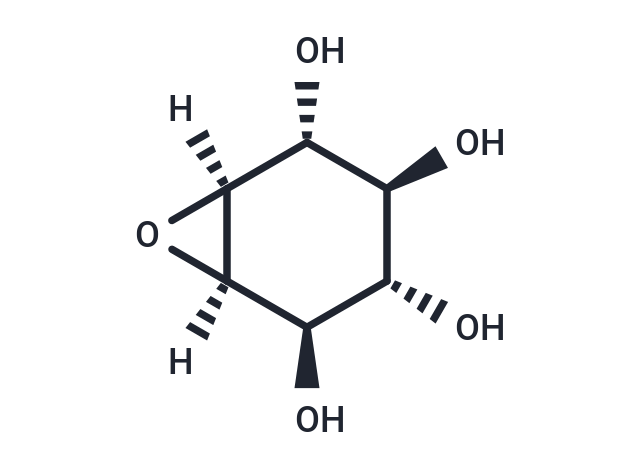Shopping Cart
- Remove All

Your shopping cart is currently empty


| Pack Size | Price | Availability | Quantity |
|---|---|---|---|
| 5 mg | $41 | In Stock | |
| 10 mg | $80 | In Stock | |
| 25 mg | $105 | In Stock | |
| 50 mg | $174 | In Stock | |
| 100 mg | $259 | In Stock | |
| 200 mg | $388 | In Stock |
| Description | Conduritol B epoxide is an irreversible inhibitor of β-glucosidase (GCase). |
| In vitro | Treating N2a and Conduritol B epoxide-N2a cells with G6 gave GC reductions to 7% and 26% of untreated levels, respectively. G6 treated Conduritol B epoxide-N2a also has significantly decreased GS. Conduritol B epoxide-N2a cells have higher calcium levels than in N2a cells without caffeine at baseline. Conduritol B epoxide-N2a cells show a significant increase in cytosolic calcium levels compared to N2a cells. Conduritol B epoxide-N2a cells show a significant reduction in OCR as evidenced by approximately 50% in all the parameters, including the rate of ATP production, basal respiration, and maximal respiration, compared to N2a cells. In dantrolene-treated Conduritol B epoxide-N2a cells, levels of Ryr3 are increased to 76% of the WT level [1]. |
| In vivo | Treatment with Conduritol B epoxide (100 mg/kg/day, i.p.) administered to 4L, 9H, 9V, and WT mice from postnatal days 5 to 11 does not result in the formation of α-synuclein aggregates. However, prolonged daily administration of this compound to 4L mice (at the same dosage starting from postnatal day 15 for either 24 or 36 doses) causes hind limb paralysis and leads to minimal α-synuclein accumulation in specific areas of the brain, including the olfactory bulb, brainstem, and periventricular region near the dorsal third ventricle (D3V) [2]. |
| Kinase Assay | Cells are homogenized in 1% sodium taurocholate/1% Triton X-100. GCase activity is determined fluorometrically using 4MU-Glucose as the substrate in 0.25% sodium taurocholate, 0.25% Triton X-100 and 0.1M citric-phosphate buffer (pH 5.6). Brain tissues are homogenized in 1X PBS and incubated in 5 μM brain phosphatidylserine and 0.1M citric-phosphate buffer (pH 5.6) for GCase activity assay using 4MU-Glucose as substrate. Protein concentrations are determined by BCA assay using BSA as standard [1]. |
| Animal Research | Gba1 point mutated 4L, 9H and 9V mice or WT mice are intraperitoneally injected with 100 mg/kg/day of Conduritol B epoxide. In short-term experiments, daily injections are initiated at postnatal day 5 and continued for 6 daily doses. The mice are sacrificed on day 12 or 2 months after the last injection. In long-term experiments, 4L mice are injected daily beginning at postnatal day 15 for 24 or 36 daily doses and sacrificed the day after the last injection. Mice are perfused with PBS and organs are harvested for enzyme activity, lipid, and histological analyses [2]. |
| Molecular Weight | 162.14 |
| Formula | C6H10O5 |
| Cas No. | 6090-95-5 |
| Storage | Powder: -20°C for 3 years | In solvent: -80°C for 1 year | |||||||||||||||||||||||||||||||||||
| Solubility Information | DMSO: 70 mg/mL (431.73 mM) H2O: ≥20 mg/mL (123.35 mM) | |||||||||||||||||||||||||||||||||||
Solution Preparation Table | ||||||||||||||||||||||||||||||||||||
DMSO/H2O
| ||||||||||||||||||||||||||||||||||||

Copyright © 2015-2024 TargetMol Chemicals Inc. All Rights Reserved.